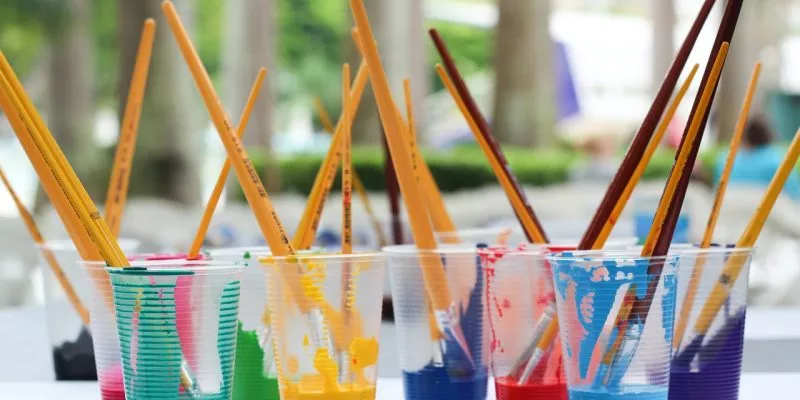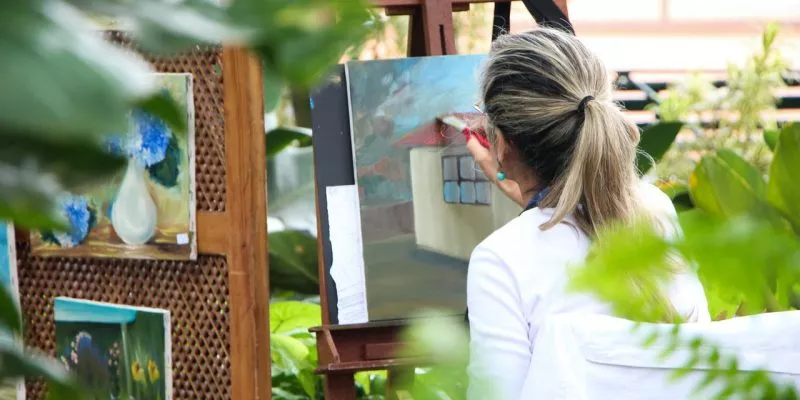For many beginners, the idea of painting something makes them freeze. This is quite natural; there are too many things they have to learn before starting painting. Firstly they have to pick what kind of painting they want to do: portraits, landscapes, or abstract? Would it be colorful or monochrome? What type of paint should they use, and what brushes?
Painting is one of the oldest forms of art, dating back thousands of years. However, with all the different styles and types of paint, brushes, canvases, and other tools available today, it's easy to feel overwhelmed when trying to decide how to get started. But it doesn't have to be complicated. Even if you aren't incredibly artistic or creative, there are still plenty of easy painting projects you can try out in your own home and enjoy the relaxation they provide.

On painting and mental health
Painting is not just a hobby but also a way to relieve stress. There are many different benefits of painting for the mind. When you choose to create a masterpiece, you release your emotions and clear your thoughts. One of the most significant benefits of painting for the mind is reducing stress and anxiety. Painting is also a great way to express your emotions without hurting anyone else. This can be very therapeutic for people who suffer from negative emotions such as anger or sadness.
Painting also helps to improve your self-esteem and creativity. Self-esteem can be improved by anything that makes you feel good about yourself. When you paint and see the image as you stroke, you will begin to see your true creativity unfold before your eyes.
Painting has been proven to help people who have depression, Alzheimer's disease, autism, schizophrenia, ADHD, and other conditions that may cause memory loss or difficulty with problem-solving skills. Painting helps to stimulate different areas of the brain and increase communication between neurons in different regions. This promotes brain health and reduces the chances of developing Alzheimer's disease and other age-related disorders.
Painting is a great way to relax, unwind, and express yourself. If you desire to learn how to paint but don't know where to begin, acrylic painting is the perfect medium for beginners.
What is acrylic painting?
Acrylic paint is a water-based paint that artists first used in the 1960s. Acrylic paint can be used thickly to cover a large area or thinly to add multiple layers and achieve more subtle or realistic effects. Acrylic paint is a good choice for beginners who have never worked with paint before because it dries quickly, so you don't need to wait long between layers.
Acrylic paints are also easy to remove from brushes and tools, so it's easy to clean up after you finish working, and you don't have to worry about paint drying on your brushes. Because acrylic is water-based, it's a good choice if you're painting outside since it won't dry out in the sun or if it gets rained on in between layers.
Acrylic painting is easy, fun, versatile, and rewarding. Kids can get a hand at painting too! It can help boost their creativity at a young age; plus, it's a fun bonding time for the whole family.
Even though it's easier than oil or watercolor painting, acrylic still has enough complexities to challenge your ability in new ways as you start to dive into the world of painting.

How to start acrylic painting for beginners?
Acrylic is an ideal medium for beginners who aren't sure how much time they want to paint or how committed they are to the craft. It is one of the most forgiving types of paints, with a quick dry time, and it's also relatively inexpensive. There isn't much room for mixing colors, but it is possible and can help you get more creative once you become more advanced.
We have a short step-by-step guide prepared for you in this article and can be followed by kids, adults, and older artists alike! For inspiration and painting ideas, you can enroll in classes about the basics of acrylic paints and how to practice acrylic painting. There are also acrylic painting workshops tailored for kids to help them enrich their creativity.
Nervous? Excited? The good news is that you don't need to be an expert — and in fact, it helps if you're not so focused on creating a picture-perfect masterpiece for your first try. To enjoy acrylic painting, you should just be having fun. Let's dive in!
To start, first, you need to secure your tools and materials. Most of the time, it's readily available at your nearest craft store, book store, or even in department stores. If you do not have one nearby or prefer to stay indoors, you can purchase them online.
Materials:
- Acrylic paint
- Paintbrushes (can vary in size)
- A painting surface, popular options are paper and canvas
- Water
- Artist palette or any thin, flat surface that you can easily hold on
- Palette knife
- Newspapers or plastic wrap
- Rags
- Optional: Acrylic-safe varnish
Step-by-step guide:
- First, think of the theme of your painting and prepare the colors needed. You can do an abstract painting, character painting, landscape, portraiture, or recreate any image or object inside your home.
- Draw a rough sketch or outline your drawing using a pencil or light charcoal. You can also skip this step if you're going straight in with the acrylics.
- Cover your work area with newspaper or plastic wrap to protect it from spills and splatters of paint. If you prefer working on a large canvas, make sure your easel is set up based on your comfort.
- Next, try to get a feel and experiment on your materials. Using a spare piece of paper, test out how fast the acrylics dry. That way, you'll be able to plan out how you'll paint your artwork. You can also test the blends between colors using your palette and palette knife.
- Paint your heart away. We highly recommend starting with more extensive areas rather than specific details, and from lighter colors to darker ones. It can help you focus clearly on your work and balance colors if needed.
- Congratulations on your first acrylic painting! Admire the masterpiece you created. Don't stress the errors or flaws too much— remember, it's your first time. Practice makes perfect, and you'll see firsthand the progress as you continue to paint.
- Since acrylics dry faster and are water-resistant, your painting can be easily preserved for an extended period. However, you can add more protection by adding a layer of acrylic-safe varnish on top. It also adds dimension and character to a painting by adding a glossy finish.
- Once done with your first masterpiece, you can learn from your experience and apply it to your next project. Maybe the color dried too fast? Should you try a different brand of acrylics? The colors did not blend too well, or did you use too much water? There's no harm in trying again and experimenting, especially in art. You can also treat yourself to a painting class to learn from the experts and learn more about acrylic painting ideas.
Painting is a therapeutic past-time
Scientists and art therapists agree on one thing: painting is a great mood booster that helps your mental health and well-being in more ways than one. From reducing stress to boosting positive emotions, you're likely to experience significant benefits from this simple activity—but be aware it takes practice to improve. So with a bit of hard work and some patience, soon you too can take part in this enjoyable pastime and create masterpiece after masterpiece.
Learn how you to paint with acrylics! Sign up for arts and crafts courses at Skill Success.


